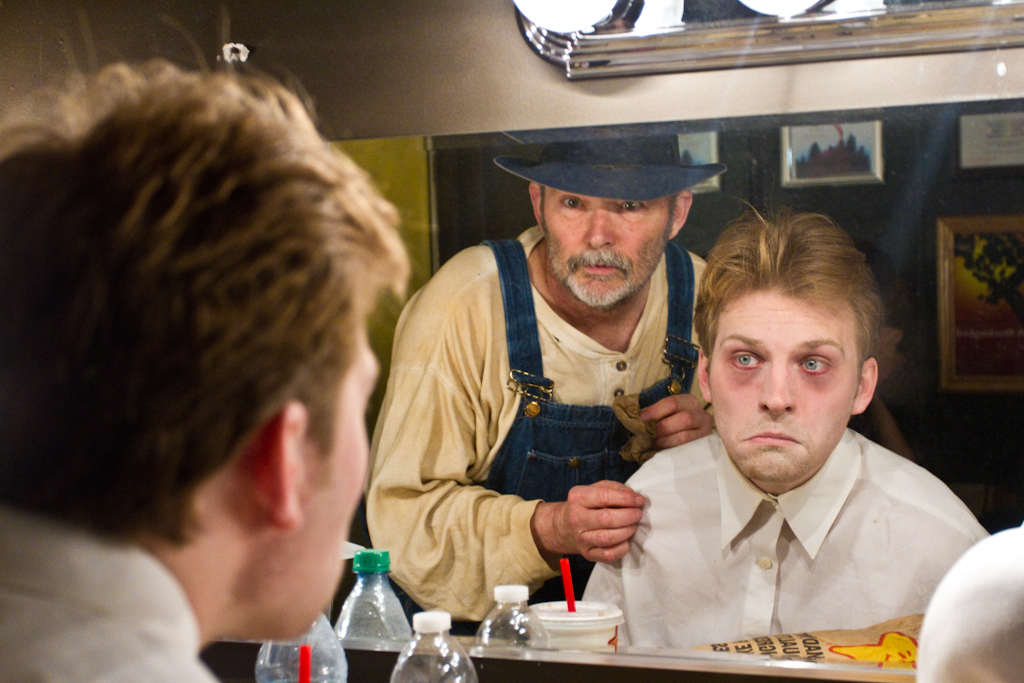
Actors Forrest Robinson and Jeremy Pfaff prepare for their performance of “To Kill a Mockingbird,” produced by Biola’s Theatre 21 and directed by Forrest Robinson (pictured left). Performances run until Nov. 12, 2011. | Tyler Otte/THE CHIMES
Lemonade, southern drawls and white screen doors — “To Kill a Mockingbird,” based on Harper Lee’s novel, appearing in Theatre 21 through Nov. 12 beckons viewers right into Maycomb, Ala. 1960.
Attorney Atticus Finch, played by Steve Pike, must prove the innocence of a black citizen accused of raping a white woman. He has hardly a lick to go off of, just the black man’s word against the woman’s. The play successfully contrasts the dogmatic views of the biased townspeople against the unfettered innocence of three local children, Scout, Jem and Dill.
Actors give believable performances
Amid a simplistic set in the black-box theater, the authentic small-town feel is masterfully captured through characters like the wizened grandmotherly figure Miss Maudie, pronounced “Mizz Maw-dee” by the southerners, and local crank Miss Dubose.
The hyper-imaginative boy Dill, played by freshman theatre major Atticus Shires, kept the audience laughing with his comically awkward and childish gestures and his tall tales which included his talent of camel washing. Whenever he appeared on stage, his skill was eye-catching.
Scout, who Pulitzer-prize winning author Harper Lee based off of herself, was played by freshman theatre major Julie Ploehn. Scout pouted and picked her toes like any unladylike girl might do while her brother Jem, played by freshman Cris Cockrell, acted the part of a more protective and emotional adolescent.
Southern upbringing of director adds to authenticity
Cruel town alcoholic and father of the alleged rape victim, Bob Ewell, was played by the director and associate professor of speech drama Forrest Robinson. Robinson previously played the role of Jem in New York alongside Holly Hunter at the Courtland Repertory Theatre. He is now part of the Biola cast of “To Kill a Mockingbird,” making it his second appearance in a Biola production.
Originally from the south, Robinson’s authentication of the tone of the play included having his family make recordings of the dialect for the actors to listen to and mimic. Robinson recalls well the bigotry that the south harbored.
“I remember water fountains with colored and white written on them,” Robinson said.
He recalled his Italian mother directing him to use the “white” fountain when he was a boy because it was protocol at the time. After he drank, though, she would turn the young Robinson around, kneel down, look straight into his eyes and stress to him, “Everybody’s the same. Remember, everybody’s the same.”
Theme ties in with recent campus discussions on diversity
It is this understanding that causes protagonist Finch to tell his children Scout and Jem that “You never really understand a person until you consider things from his point of view — until you climb into his skin and walk around in it.”
That is what this play is truly about, seeing past the archaic and unjust barriers that are created between people out of fear and ignorance. Robinson thought the piece would be very healing to the on-campus climate which has been toiling with the discussion of diversity.
“To Kill a Mockingbird” artistically portrays themes of bigotry and the fight for truth in a thought-provoking and well-cast performance. Aside from actors occasionally turning their back to the audience and the soft-spoken dialect of one or two smaller characters, the play has few hiccups to distract its viewers from the heart of its message.
The play is easily worth the $11.50 general admission price for its animated cast, powerful message of racial equality and engaging experience. Be warned: If you are a single male attending the show you may end up being part of the jury who are called from the audience to use reason and truth to judge past socially biased worldviews and decide the verdict of the alleged rapist.







